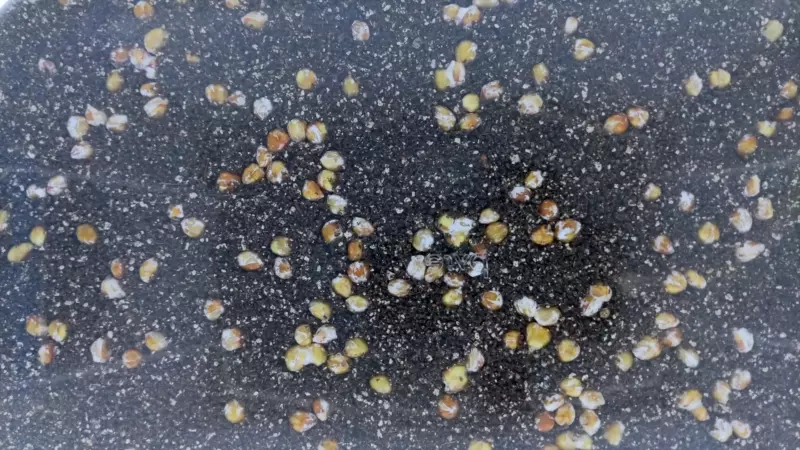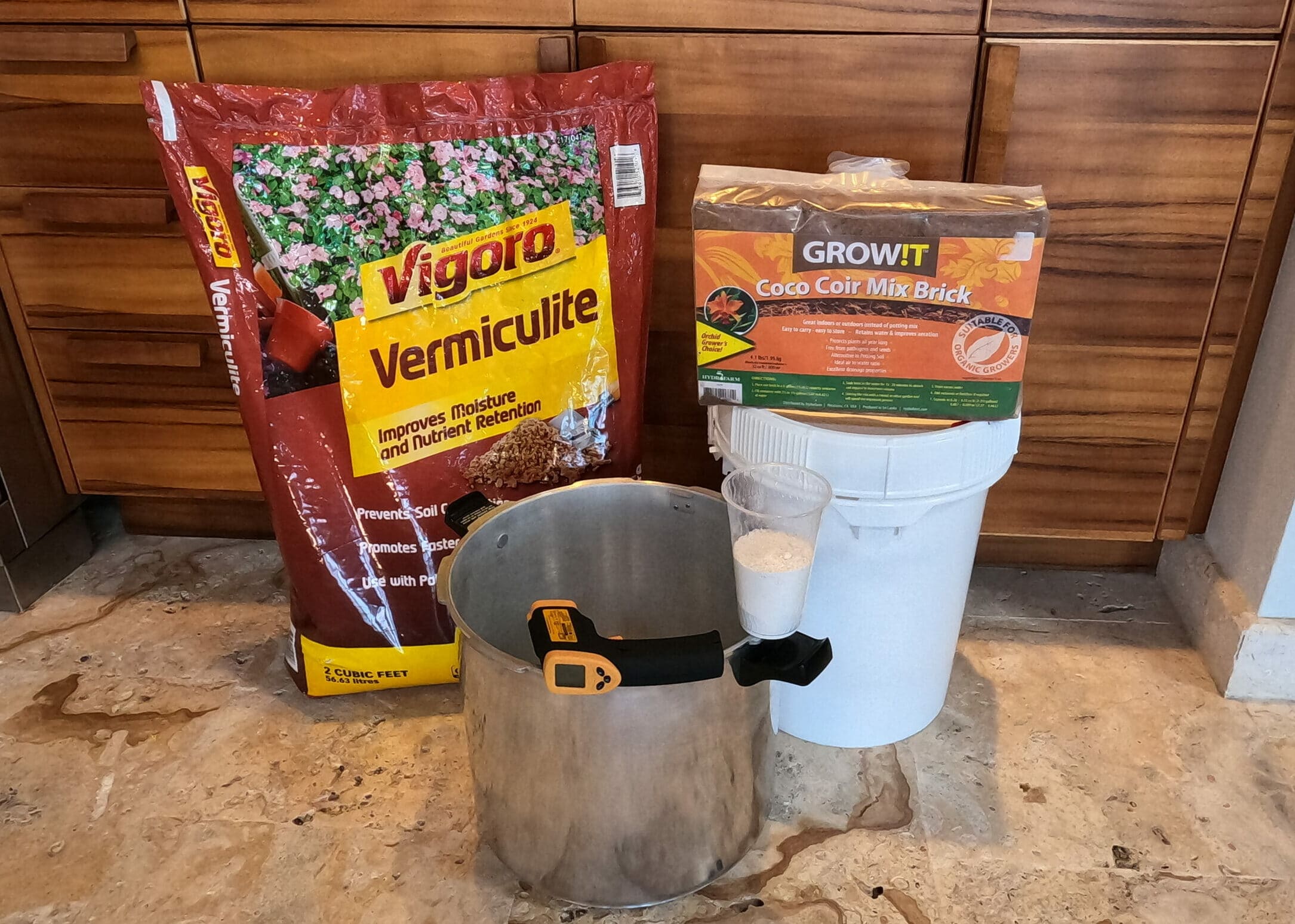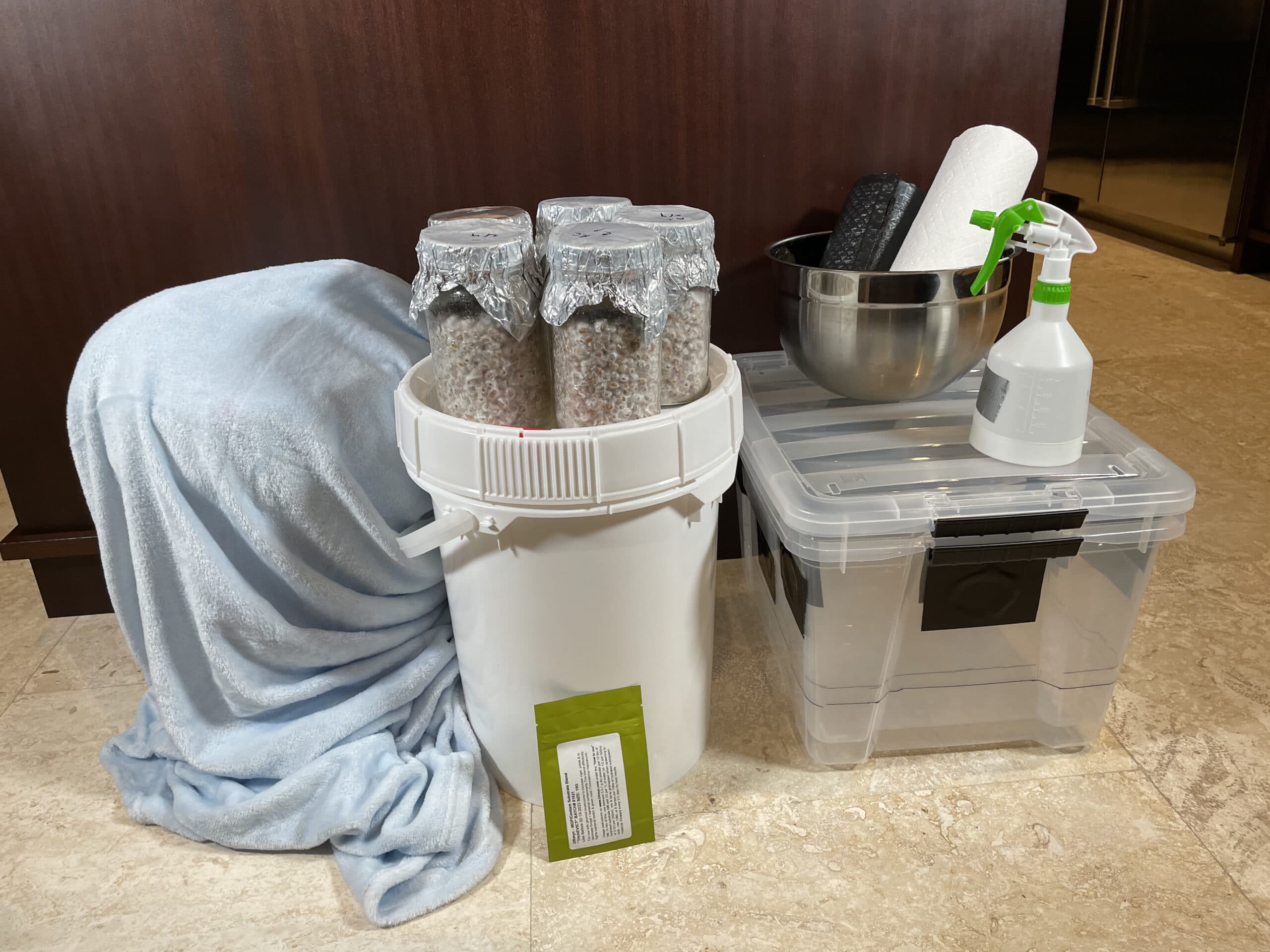Now it’s finally time to open your pasteurized bulk substrate. Touch the bucket to make sure it is at room temprature before using it. All the ingredients will need a good mixing now. Break up the coco-coir brick and pulverize all the small chunks. Slowly work your way down to the bottom of the bucket. The gypsum tends to accumulate in the bucket corners, so really dig down and mix everything well. By mixing, you’re also distributing the water content in the substrate more evenly.
Ideally, you want there to be just enough water in the substrate for the mushrooms to be happy, but not so much that your tub gets waterlogged. This magical balance point is called “field capacity”. If you used our recipe, you should be good to go. To test field capacity, tightly squeeze a handful of substrate. You should barely be able to squeeze out a few drops of water. Mix well every time you add water. You really want to spread the water around evenly. If you find that you have exceeded field capacity and the substrate is too wet, squeeze the excess liquid out until field capacity is reached. Close the bucket.
Now it’s time to break up the spawn in the jars. Get something to soften the blow on the jars, like a book and / or a towel. Remove the aluminium covers from the jars. Inspect each jar for contamination. Green moulds, black fluff or slime are all bad signs. Only use the jar if it has clean, white mycelium going all through the grain. Now take the jars one by one, and start tapping them on the towel and book. You want the grain to break up so that you will be able to pour it out of the jar. Don’t tap it too hard. Just go slow and steady. Once completed, leave the jars closed, and bring them back to the bulk substrate buckets.
Take a handful of the clean substrate which you placed earlier in the metal bowl, and sprinkle it over the mixture. You want to create a thin, even layer of grainless substrate that just covers the grain/substrate mixture. Spread this casing layer around evenly all over the surface, and gently pat it down. Spray a final round of Dr MYC on the surface of the casing layer. Make sure you get all the sides and corners as well.




13 Responses
I want Enigma! What is the potency of those freaky, mean, weird mutants. Mentioned test revealed it was stronger. I really like the way you have the truth! Spread it to the people. CVG’s are where it’s at! Mono tubs. I mean you did a great job with this. And I would like to thank you for that.
I found it confusing using measurements of 600g( by weight ) v in the written instructions and using volumetric measurements of 4q in the video.
My 600 g vermiculite was like 8 quarts
Go figure
Good point. I’ll try to standardize this section a bit better. I also find that the volume to weight ratio changes with particle sizes.
What would be the approximate yield doing it this way?
Good question. The yield depends greatly on many factors, such as nutrient levels of the substrate, temperatures, fruiting conditions, humidity, contamination, etc. Assuming everything is dialed in, a yield of about 1-1.5 kilos of fresh mushrooms can be expected. When dried out, this could end up being around 120g dried mushrooms. This yield could be increased substantially (x3) if a more nutrient rich substrate was used, for example, including dry horse manure to the CVG substrate before pasturization. This however, may also increase the risk of contamination, which is why we don’t recommend you try this as your first growing experience.
how should excess liquids, petri dishes, spores, be stored? everything refrigerated?
Yes. If you’re not interested in generating more growth from the LC / petri dish, you can store them in a fridge for extended periods of time. I have had liquid cultures stay viable for several months in the fridge.
If I am using a 66qt mono tub, what is the ratio of all the ingredients needed including how many qt jars of spawn? Thanks.
A 66qt monotub should be large enough to hold all the substrate made in a single tub using the recipe on this site. Ratios wouldn’t need to change.
Very clear and easy to understand. Thankyou! I have done maybe 6 grows succesfully since Oct. 2022. Funny Every time I get ready to put the spawn to substrate I have to look this up. This time I found you. Why do others try to complicate such an easy straightforward process I don’t know. But after reading your “How to” I don’t think I’ll have to look it up again. Thanks.
1 question. This time I am using a peat moss and vermiculite calcium mixture that I had from another vendor. I decided to add about half Coco coir before I pasteurized. Does this sound like a good idea to you? I haven’t added spawn yet. Just curious what you think. Thanks in advance!
Two things, and a suggestion: 1) If i remember correctly, peat moss and calcium hydroxide is often used as a casing layer for the substrate, to protect it from contaminants and to help keep it hydrated. I don’t think it should be used as a substrate itself. 2) There’s always a very delicate balance with bulk substrate. On one hand you want there to be as much nutrients for the mushrooms as possible, but on the other – the more nutrients, the more likely to contaminate. I suspect all the complexity around the topic which you are reading has to do with that. Some people add cow/horse manure, some use worm castings, others just CVG. My suggestion is this: For the first few grows, use CVG only, until you feel confident in the grow process. Once you have a few successful grows under your belt, try to improve your bulk substrate by adding 30% composted / sun dried horse manure to your it (of course, after a really good pasteurization). You will notice a big difference in the fruiting bodies. Good luck!
I’ve always been a visual learner and after scouring forums for hours with little progress, ive learned everything ive needed in about an hour watching your videos. Thank you so much 🙂
Setting up the monotub doesn’t seem very sterile and seems risky in that respect? No SAB, colonised grain out in the open air for long periods of time. If it didn’t work you wouldn’t have made it this way I know :), I’m just curious why I’m wrong?
Thanks again.
Thank you! Your instincts are correct. Once you break out that colonized grain out of the bag / jar, you’ve already subjected it to contamination. However, at this stage of development of the mycelium, with the large amount of contact / inoculation points the mycelium gets with the substrate, it ends up colonizing the substrate very fast, and out-competes the other nasties. So while the first few stages of mushroom cultivation need to be sterile, this last part does not. Saying that, the less contamination you introduce into the monotub process, the better, as your mycelium cake will get more flushes and milage. For more sensitive species and substrains, i will occasionally make my monotub in front of a flow hood…but the process is too complex (for me) to do with a SAB.